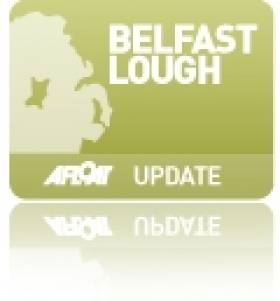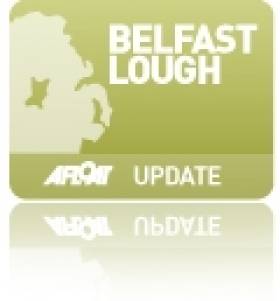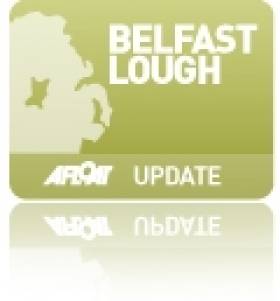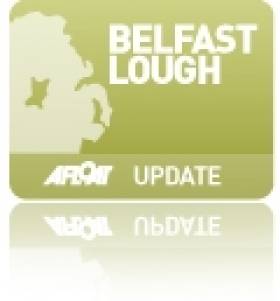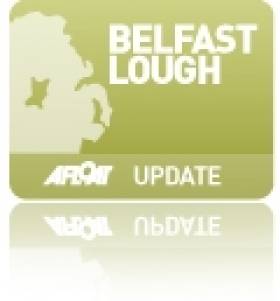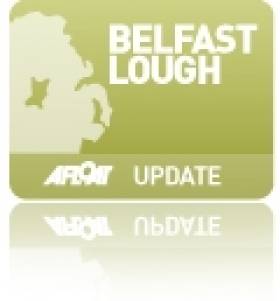Displaying items by tag: Belfast Lough News
Harland & Wolff Appoints New Director of Ship & Offshore Unit Repair
#H&Wdirector- Harland & Wolff Heavy Industries has appointed James Lappin as the new Director of Ship & Offshore Unit Repair.
The new position will involve total responsibility for developing and growing the Belfast company's business in this sector and execution of its projects.
Lappin who is a Mechanical Engineer joined Harland & Wolff as a Graduate Trainee Manager in 1999 before leaving to develop his career with blue chip offshore energy companies including BP, KBR and Fred Olsen Renewables.
In 2011 he re-joined H&W as Ship & Offshore Unit Repair Manager, overseeing a range of projects.
Among them as previously reported on Afloat.ie the Husky SeaRose FPSO (see photo) a floating production storage offshore vessel and more recently the Blackford Dolphin Drilling Rig project.
#CruiseBelfast- Belfast Harbour's bumper cruise season is to have a total of 61 callers this year, among them the largest cruiseship ever to visit the port, the newbuild Royal Princess which has a capacity of 3,600 passengers, writes Jehan Ashmore.
The 141,000 tonnes Princess Cruises ship has 1,780 cabins and a crew of 1,300 and she is to arrive on 18 September. She is one of several large cruise callers attracted to Belfast because of the various attractive tourism options to offer cruise-operators.
At the other end of the cruiseship scale at under 10,000 tonnes is the prestigious Seabourn Legend which is visiting Belfast today. She is on her final cruise of Irish & UK ports for Seabourn Cruises and as previously reported she called to Dun Laoghaire yesterday.
Cruise Belfast, a marketing partnership between Visit Belfast and Belfast Harbour is expected to generate a total of 110,000 passengers and crew to visit the city by the end of October. The partnership is also to attract to the city major stop-over calls of the travel itineraries operated by the world's leading cruiseship companies.
The boost to Belfast fortunes is reflected in that the harbour as an international desination is outperforming other key UK port-cities among them Liverpool and Glasgow. In addition Belfast is now ranked as the second most popular cruise city on the island of Ireland with only Dublin surpassing in cruise visitor numbers.
#H&Wlosses - Harland & Wolff, the shipbuilder-turned renewable energy giant manufacturer, suffered a £3.8m loss in 2013, according to newly-filed results.
Directors have said that the "very unsatisfactory" results were down to escalating project costs, leading to a review of the organisation, its structure and processes.
The group generated an operating loss of £3.8m on a turnover of £32m after two profitable years of trading and a good performance in a number of sectors in 2013.
In its annual report, the company said its flotation tank project with Norwegian firm Kvaerner Verdal AS had incurred "significant cost overruns".
However, the annual report said that the overall financial position of the company remained strong and debt free and that it was taking measures to ensure the losses were "a one-off and will not be repeated".
To read much more on this story, The Belfast Telegraph has a report HERE.
#TitanicPumpHouse – The Belfast Telegraph writes that the historic pump-house that was used for the dock in which the RMS Titanic was built, is to be transformed into a visitor centre for HMS Caroline.
The listed building is the subject of a new planning application by the National Museum of the Royal Navy, which is working towards reopening HMS Caroline to public view in 1916.
HMS Caroline is one of the most historic fighting ships in the world and is the last remaining survivor of the Battle of Jutland, the largest ever maritime battle during the First World War.
She is to be restored to her former glory and it is hoped she will reopen in time for the centenary of the battle at the end of May 1916. To read more details of the plan, click HERE.
As previously reported on Afloat.ie, repairs were carried out late last year on HMS Caroline that involved vital weatherproofing as part of the major restoration programme.
#GiantOilRig – A giant oil-rig the Blackford Dolphin, which was initially only supposed to be in Belfast for a six-week refurbishment, is to finally depart Belfast today after six months dominating the city's skyline.
As previously reported on Afloat.ie, the platform is one of the world's biggest such structures, the 260ft rig, that sailed into the harbour before Christmas, will be heading back to Norway at a snail's pace after her multi-million pound refit at Harland & Wolff, which employed some 400 workers on the project.
The contract price for the work is thought to be over £100m.
While the initial work schedule was only supposed to take 60 days, following the discovery of some structural defects on the rig when it came into the world's largest dock, the structure underwent months more repairs by welders, electricians, painters and engineers from the UK, Poland and Portugal.
For much more detail on this story, The Belfast Telegraph has a report HERE.
#BelfastCityQuays - A £250m, 20-acre Belfast city quays development proposed by Belfast Harbour with outline planning permission has been awarded approval.
The water-side development will be office led and also include retail, residential, a hotel and a car park.
Welcoming today's award of outline planning permission for City Quays, Graeme Johnston, Belfast Harbour's Property Director said: "City Quays is an extension of the highly successful Clarendon Dock development. The 20-acre development will regenerate a significant section of Belfast's waterfront and help reconnect the river frontage to the city centre.
"City Quays is an office-led, mixed use scheme which will be of particular appeal to potential inward investors and growing local businesses. Construction is underway for the first office in the development.
The award of outline planning approval for the entire scheme will enable Belfast Harbour to progress more detailed plans and showcase the full City Quays project to potential investors."
H&W Prepares to Say Farewell to Giant Oil Platform
#GiantOilRig- Work is now nearing completion at Harland & Wolff which has been carrying out specialised emergency work on one of the world's biggest oil platforms, the Irish News has confirmed.
Depending on the tides in Belfast lough, the 360-foot Blackford Dolphin oil drilling rig - which as previously reported on Afloat.ie, has been in dry dock on Queen's Island since before Christmas - will finally head for home in Norway.
The multi-million-dollar renovation project on the rig, a vast industrial behemoth which has dominated the titanic Quarter skyline for months, was meant to take just 60 days. For more on the story click here.
Harland and Wolff Samson Gantry Breaks World Record
#SamsonsWorldRecord - The Belfast Telegraph reports that Harland and Wolff has broken a world record at the Belfast shipyard - by performing the world's heaviest single point WaterLoad test
As previously reported on Afloat.ie, the massive Samson gantry which was cast in pink lights during the prestigious Giro d'Italia, lifted an incredible 774 tonne load to certify Harland and Wolff's latest spreader beam arrangement.
The spreader beam has been a strategic investment to support the company's handling capability for large offshore structures such as jackets and offshore modules.
The load test bags were provided by Unique Seaflex, who are specialists in marine air lift buoyancy bags and water load test weights.
They provided 24 bags of various capacities which, when filled with water, provided the total load of 766 tonne - which is the world's heaviest single point WaterLoad test.
For more including video footage of the the World's biggest single point waterload 'big-lift', click here.
#GiantOilRig – A giant oil rig, initially set for a whistle-stop 60-day renovation project in Belfast, will now see the Blackford Dolphin remain in the city's docks until June.
As previously reported on Afloat.ie, the Blackford Dolphin, a 360ft high structure sailed into the Harland & Wolff shipyard in early December from Brazil for a refit.
In March, following the discovery of the need for additional "emergent" work, the rig's owners Dolphin Drilling told the Norwegian Stock Exchange that the work would continue until April.
However, that deadline has now been extended again for almost another two months – and the race is on to finish the work. For more on this story, the Belfast Telegraph reports.
#GiantFPSO - Work on another oil rig completed by Harland & Wolff in 2012 had helped clinch the multi-million pound Blackford Dolphin deal, writes The Belfast Telegraph.
One thousand workers helped completed the one-month project on the SeaRose FPSO "floating production, storage and offloading vessel" for the Canadian firm Husky Energy.
As pictured above by Afloat.ie, the giant floating factory left Belfast four days early, under budget and with no injuries or environmental incidents, before sailing to Newfoundland.
Once the current job is completed, the Blackford Dolphin as previously reported on Afloat.ie will move to the North Sea, where it will begin its next drilling contract with MPX and Capricorn, respectively. Despite the decline in shipbuilding, Harland & Wolff is carving a new niche in the offshore and renewables markets.
The most recent ship built at the yard was the MV Anvil Point, which left Harland & Wolff in 2003. It was owned by a consortium including the Bibby Line company, ironically the owners of the Venetian, the very first ship built by the Belfast shipyard.



























